Observational Evidence of the Need for Gender-Sensitive Approaches to Wildfires Locally and Globally: Case Study of 2018 Wildfire in Mati, Greece
Abstract
1. Introduction
Scope and Objective of the Study
2. Research Methodology
2.1. The Michelangelo Workshop (MW)
2.2. The Network of the Mediterranean Network of Engineering Schools (RMEI)
3. Research Questions and Conceptual Frameworks
- Is there any link between wildfires and genders?
- Why address gender issues in wildfire management and policies at all levels—is it important?
- What action should we take?
- Why does gender matters in resilience programming?
3.1. Natural Disasters
3.2. Wildfires
3.3. Vulnerability
3.4. Adaptability-Transformability
3.5. Mitigation
3.6. Transformability-Resilience
- ❖
- Engineering resilience is the degree to which a system approaches steady-state and returns to equilibrium after a disturbance [36].
- ❖
- ❖
- Resilience in ecological systems is the amount of disturbance that a system can absorb, without changing the stability domains [38]. The loss of resilience brings a change in the system state, signaled as a resource crisis [30]. Ecological systems are coupled with social ones, since humans are part of the ecosystem [39].
- ❖
- Social–ecological resilience is “the capacity of social–ecological systems to absorb recurrent disturbances to retain essential structures, processes and feedbacks” [40].
- ❖
- Equitable resilience identifies critical issues for engaging with equity in resilience practice [40]. Taking a gender-responsive approach to mainstream and accelerated climate actions across the globe, towards empowering women. Women and girls should be the central drivers of these actions as they provide safety and security for their families, and educate future generations [32].
3.7. Control-Based Wildfire Management
- fire regimes,
- probable fire effects,
- level of risk,
- level of forest protection,
- cost of fire-related activities,
- appropriate technologies required.
- Restoration of the system to a desirable level.
- Allowing the system to return to a stable domain by itself.
- Adapting to the system that has changed.
- The control-based management approach.
- The resilience approach.
- ▪
- Prevention.
- ▪
- Early warning.
- ▪
- Detection.
- ▪
- Mobilization.
- ▪
- Appropriate use of natural or human forces.
- ▪
- Reducing the accumulation of residues and wastes from commercial or non-commercial activities.
- ▪
- Rehabilitation of ecosystems damaged.
3.8. Resilience-Based Wildfire Management
- Restoring or maintaining ecological resilience.
- Increasing individuals and community’s resilience.
- Reducing the resulting loss of life and properties by wildfires, and calls for the involvement of socially diverse local communities, as because people from different cultural backgrounds respond differently to wildfire risk, as do men and women [50].
3.9. Gender Equality and Climate-Based Hazards
- ▪
- Belief that femininity equals weaknesses.
- ▪
- Preconception that women are not linked to leadership excellence.
- ▪
- The dominating situation of built-in defensive mechanisms that make cultural change difficult.
3.10. Towards SDGs Agenda 2030
4. Case Study
4.1. Wildfires in the Mediterranean
- ❖
- Mati (Greece, 23 July 2018, 99 fatalities)
- ❖
- Central Region (Portugal, 15 October 2017, 53 fatalities).
- ❖
- Pedrogao Grande (Portugal, 17 June 2017, 66 fatalities).
- ❖
- Horta de Sant Joan (Tarragona, Spain, 21 July 2009, 5 fatalities).
- ❖
- Makistos–Artemida (Peloponnese, Greece, 24 June 2007, 30 fatalities).
- ❖
- Riba de Saelices (Guadalajara, Spain, 17 July 2005, 11 fatalities).
- ❖
- Ikaria (Ikaria island, Greece, 30 July 1993, 13 fatalities)
- ❖
- Curraggia (Sardinia, Italy, 27–28 July 1983, 9 fatalities).
- ❖
- Agueda (Portugal, 14 June 1986, 16 fatalities).
- ❖
- Armamar (Portugal, 8 September 1985, 14 fatalities).
- ❖
- La Gomera (Canary Islands, Spain, 11 September 1984, 20 fatalities).
- ❖
- Lloret de Mar (Girona, Spain, 7 August 1979, 21 fatalities).
- ❖
- Sintra Mountains (Portugal, 7 September 1966, 25 fatalities).
4.2. The Wildfire of 2018 in the Mati Village, Attica Region, Greece
- 99 humans lost their lives (55 women, 45 men, including children)
- 164 people were heavy injured.
- Over 700 residents were evacuated or rescued.
- More than 4000 residents were affected.
- Hundreds of square kilometers of pine tree forest were burned.
- More than 1500 buildings and houses were destroyed/damaged.
- 305 vehicles were burnt.
- Severe damages were caused to electricity, telecommunication, and water supply network.
- Besides the direct losses, long-term impacts involved the following [77].
- Health issues from impaired air quality, due to wildfire smoke and heavy metals and plastics melting.
- Disruption in tourism, business, and recreation revenue.
- High accumulation of different kinds of post-hazard wastes.
4.3. Interviews for Boosting the Case Study
- The first interview was conducted with the Fire Brigade Operations Coordinator (male). The second interview was conducted with a journalist/meteorologist (male) on Greek TV. The third interview was conducted with a University professor (female).
- Then, we analyzed these interviews. Based on the results, we provided a detailed checklist aimed at resilience dialogue. The replies were compiled in the discussion of this study, which were focused on presenting arguments for the enrichment of action research methodology on differentiated vulnerabilities, adding arguments and crucial inspirations for future planning-approaches.
- ▪
- Lack of awareness and preparedness.
- ▪
- Lack of evacuating skills by the residents.
- ▪
- Lack of trust in the woman.
4.3.1. Interview I: Preparedness to Wildfires in Greece
4.3.2. Interview II: Global Warming and Wildfire Hazards Links
4.3.3. Interview III: Gender Equality and Wildfire Management
5. Discussion and Lessons Learnt
‘Have the risks to wildfire hazards and resilience links to gender equality?’
- Perception of risk.
- Preparedness behavior.
- Warning communication and response.
- Physical impacts.
- Psychological impacts.
- Emergency response.
- Recovery.
- Reconstruction.
- Ensuring the equal participation of men and women in implementation, adaptation, and mitigation to climate changes disasters.
- Ensuring women can act as agents of change at different levels of adaptation and the mitigation process.
- Promoting mitigation approaches that are aware of gendered implications.
- Developing equal participation in the deployment of financial resources, particularly at the local level.
- Taking a gender-sensitive approach to creating, developing, and strengthening institutional, systemic, and human-resource capacity-building, to foster gender balance in decision-making, and accessing means and tools for the implementation of mitigation or adaptation actions.
6. Recommendations
6.1. Resilience Planning
6.2. Collaboration and Participation
6.3. Gender-Sensitive Approaches
6.4. Positive Arguments
7. Conclusions
Author Contributions
Funding

Institutional Review Board Statement
Informed Consent Statement
Data Availability Statement
Acknowledgments
Conflicts of Interest
References
- IPCC Report. Summary for Policymakers of IPCC Special Report on Global Warming of 1.5 °C Approved by Governments. Intergovernmental Panel on Climate Change. 2018. Available online: https://www.ipcc.ch/2018/10/08/summary-for-policymakers-of-ipcc-special-report-on-global-warming-of-1-5c-approved-by-governments/ (accessed on 20 April 2020).
- Guterres, A. Goal 13: Take Urgent Action to Combat Climate Change and Its Impacts. Climate Action Summit. 2019. Available online: https://www.un.org/sustainabledevelopment/climate-change/ (accessed on 20 April 2020).
- Izakovičová, Z.; Miklós, L.; Miklósová, V. Integrative Assessment of Land Use Conflicts. Sustainability 2018, 10, 3270. [Google Scholar] [CrossRef]
- Zabaniotou, A.; Syrgiannis, C.; Gasperin, D.; de Hoyos Guevera, A.-J.; Fazenda, I.; Huisingh, D. From Multidisciplinarity to Transdisciplinarity and from Local to Global Foci: Integrative Approaches to Systemic Resilience Based upon the Value of Life in the Context of Environmental and Gender Vulnerabilities with a Special Focus upon the Brazilian Amazon Biome. Sustainability 2020, 12, 8407. [Google Scholar]
- European Institute for Gender Equality. Review of the Implementation in the EU of Area K of the Beijing Platform for Action: Women and the Environment Gender Equality and Climate Change; Publications Office of the European Union: Luxembourg, 2012; ISBN 978-92-9218-026-3. [Google Scholar]
- Walker, H.M.; Reed, M.G.; Fletcher, A.J. Wildfire in the news media: An intersectional critical frame analysis. Geoforum 2020, 114, 128–137. [Google Scholar] [CrossRef]
- Neary, D.G.; Leonard, J.M. Physical Vulnerabilities from Wildfires: Flames, Floods, and Debris Flows. In Natural Resources Management and Biological Sciences; IntechOpen Limited: London, UK, 2019. [Google Scholar] [CrossRef]
- Bibri, S.E. Backcasting in futures studies: A synthesized scholarly and planning approach to strategic smart sustainable city development. Eur. J. Futures Res. 2018, 6. [Google Scholar] [CrossRef]
- Bell, J. Doing Your Research Project: A Guide for First Time Researchers in Education, Health and Social Science, 3rd ed.; Open University Press: Maidenhead, UK, 2009. [Google Scholar]
- Yin, R.K. Case Study Research Design and Methods: Applied Social Research and Methods Series, 2nd ed.; Sage Publications Inc.: Thousand Oaks, CA, USA, 1994. [Google Scholar]
- Yin, R.K. Case Study Research: Design and Methods, 3rd ed.; Sage Publications Inc.: Thousand Oaks, CA, USA, 2003. [Google Scholar]
- Stake, R.E. The Art of Case Study Research; Sage Publications Inc.: Thousand Oaks, CA, USA, 1995. [Google Scholar]
- Baxter, P.; Susan Jack, S. Qualitative Case Study Methodology: Study Design and Implementation for Novice. Qual. Rep. 2008, 13, 544–559. [Google Scholar]
- Arksey, H.; Knight, P.T. Designing an Interview-Based Study. In Interviewing for Social Scientists; 1999; Available online: https://methods.sagepub.com/book/interviewing-for-social-scientists (accessed on 20 January 2021). [CrossRef]
- Bolderston, A. Conducting a Research Interview. J. Med. Imaging Radiat. Sci. 2012, 43, 66–76. [Google Scholar] [CrossRef]
- Young, J.; Rose, D.C.; Mumby, H.S.; Benitez-Capistros, F.; Derrick, C.J.; Finch, T.; Garcia, C.; Home, C.; Marwaha, E.; Morgans, C.; et al. A methodological guide to using and reporting on interviews in conservation science research. Methods Ecol. Evol. 2018, 9, 10–19. [Google Scholar] [CrossRef]
- Liritzis, I.; Westra, A.; Miao, C. Disaster Geoarchaeology and Natural Cataclysms in World Cultural Evolution: An Overview. J. Coast. Res. 2019, 35, 1307–1330. [Google Scholar] [CrossRef]
- Neale, T.; Jessica, K.; Weir, J.K. Navigating scientific uncertainty in wildfire and flood risk mitigation: A qualitative review. Int. J. Disaster Risk Reduct. 2015, 13, 255–265. [Google Scholar] [CrossRef]
- Hanson, C. Wildfire in the Age of Climate Change. Bioscience 2018, 68, 146–148. [Google Scholar] [CrossRef]
- Fernades, P.; Botelho, H. Analysis of the prescribed burning practice in the pine forest of northwestern Portugal. J. Environ. Manag. 2004, 70, 15–26. [Google Scholar] [CrossRef] [PubMed]
- Moody, J.A.; Shakesby, R.A.; Robichaud, P.R.; Cannon, S.H.; Martin, D.A. Current research issues related to post-wildfire runoff and erosion processes. Earth Sci. Rev. 2013, 122, 10–37. [Google Scholar] [CrossRef]
- Mouillot, F.; Rambal, S.; Joffre, R. Simulating climate change impacts on fire frequency and vegetation dynamics in a Mediterranean-type ecosystem. Glob. Chang. Biol. 2002, 8, 423–437. [Google Scholar] [CrossRef]
- Moreira, F.; Rego, F.C.; Ferreira, P.G. Temporal (1958–1995) pattern of change in cultural landscape of northwestern Portugal: Implication for fire occurrence. Landsc. Ecol. 2001, 16, 557–567. [Google Scholar] [CrossRef]
- Martınez, J.; Vega-Garcia, C.; Chuvieco, E. Human-caused wildfire risk rating for prevention planning in Spain. J. Environ. Manag. 2009, 90, 1241–1252. [Google Scholar] [CrossRef]
- Li, Q.; Xue, L.; Chen, H. Effects of a Wildfire on Selected Physical, Chemical and Biochemical Soil Properties in a Pinus massoniana Forest in South China. Forests 2014, 5, 2947–2966. [Google Scholar]
- Adger, W.N. Vulnerability. Glob. Environ. Chang. 2006, 16, 268–281. [Google Scholar] [CrossRef]
- Thomas, K.; Hardy, D.; Heather, L.; Mendez, M.; Orlove, B.; Rivera-Collazo, I.; Roberts, J.T.; Rockman, M.; Warner, B.P.; Winthrop, R. Explaining differential vulnerability to climate change: A social science review. Wiley Interdiscip. Rev. Clim. Chang. 2018, 10, e565. [Google Scholar] [CrossRef]
- Ribot, J. Vulnerability does not fall from the sky: Toward multiscale, pro-poor climate policy. In Social Dimensions of Climate Change: Equality and Vulnerability in a Warming World; Robin, M., Andrew, N., Eds.; The World Bank: Washington, DC, USA, 2010. [Google Scholar]
- Millar, C.I.; Stephenson, N.I. Temperate forest health in an era of emerging megadisturbance, Review. Science 2015, 349, 823–826. [Google Scholar] [CrossRef]
- Stevens-Rumann, C.S.; Kemp, K.B.; Higuera, P.E.; Brian, J.; Harvey, B.J.; Rother, M.T.; Donato, D.; Morgan, P.; Veblen, T.T. Evidence for declining forest resilience to wildfires under climate change. Ecol. Lett. 2017, 21. [Google Scholar] [CrossRef]
- Gunderson, L.H. Stepping Back: Assessing for Understanding in complex regional systems. In Bioregional Assessments: Science at the Crossroads of Management and Policy; Johnson, N.K., Swanson, F., Herring, M., Greene, S., Eds.; Island Press: Washington, DC, USA, 1999. [Google Scholar]
- UNPD. Gender Equality in National Climate Action: Planning for Gender-Responsive Nationally Determined Contributions. 2017. Available online: https://www.undp.org/content/undp/en/home/librarypage/womens-empowerment/gender-equality-in-national-climate-action-planning-for-gender-.html (accessed on 20 January 2021).
- Glantz, M.J.; Chamberlain, M.C.; Liu, Q.; Hsieh, C.C.; Edwards, K.R.; Van Horn, A.; Recht, L. Gender disparity in the rate of partner abandonment in patients with serious medical illness. Cancer 2009, 115, 5237–5342. [Google Scholar] [CrossRef] [PubMed]
- Mclennan, B.; Handmer, J. Reframing responsibility-sharing for bushfire risk management in Australia after Black Saturday. Environ. Hazards 2012, 11, 1–15. [Google Scholar] [CrossRef]
- Folke, C.; Carpenter, S.R.; Walker, B.; Scheffer, M.; Chapin, T.; Rockström, J. Resilience thinking: Integrating resilience, adaptability and transformability. Ecol. Soc. 2010, 15, 20. Available online: http://www.ecologyandsociety.org/vol15/iss4/art20/ (accessed on 20 January 2021). [CrossRef]
- Folke, C.; Carpenter, S.; Walker, B.; Scheffer, M.; Elmqvist, T.; Gunderson, L.; Holling, C.S. Regime Shifts, Resilience, and Biodiversity in Ecosystem Management. Annu. Rev. Ecol. Evol. Syst. 2004, 35, 557–581. [Google Scholar] [CrossRef]
- Berkes, F.; Jolly, D. Adapting to climate change: Social-ecological resilience in a Canadian western Arctic community. Conserv. Ecol. 2002, 5, 18. [Google Scholar] [CrossRef]
- Gunderson, L.H. Annual Review Ecologh Systematics: Ecological Resilience -in theory and application Dept. of Environmental Studies, Emory University. Available online: https://www.annualreviews.org/journal/ecolsys (accessed on 20 January 2021).
- Brand, F.S.; Jax, K. Focusing the meaning(s) of resilience: Resilience as a descriptive concept and a boundary object. Ecol. Soc. 2007, 12, 23. Available online: http://www.ecologyandsociety.org/vol12/iss1/art23/ (accessed on 20 January 2021). [CrossRef]
- Kurukulasuriya, P. Women are key to the resilience of our people and our planet- Creative gender-responsive climate and environment actions key to achieving Paris Agreement Goals. United Nations Development program, Sustainable Development Goals. 2018. Available online: https://www.undp.org/content/undp/en/home/blog/2018/Women-are-key-to-the-resilience-of-our-people-and-our-planet.html (accessed on 20 January 2021).
- Corona, P.; Ascoli, D.; Barbati, A.; Bovio, G.; Colangelo, G.; Elia, M.; Garfì, V.; Iovino, F.; Lafortezza, R.; Leone, V.; et al. Chianucci Fr Integrated forest management to prevent wildfires under Mediterranean environments. Ann. Silvic. Res. 2015, 39, 1–22. [Google Scholar]
- Hoekstra, A.; Buurman, J.; van Ginkel, K.C.H. Urban water security: A review. Environ. Res. Lett. 2018, 13, 053002. [Google Scholar] [CrossRef]
- Achberger, C.-A. Vulnerability to Natural Hazards: A Gender Perspective in Disasters. Bachelor Thesis, Management Center Innsbruck, Innsbruck, Austria, 2015. [Google Scholar] [CrossRef]
- WHO 2015—World Health Organization (2015), Gender. Available online: www.who.int/topics/gender/en/ (accessed on 21 May 2015).
- FAO. Fire management: Voluntary guidelines. In Principles and Strategic Actions; Fire Management Working Paper 17; FAO: Rome, Italy, 2006. [Google Scholar]
- Hurlbert, M.J.; Krishnaswamy, E.; Davin, F.X.; Johnson, C.F.; Mena, J.; Morton, S.; Myeong, D.; Viner, K.; Warner, A.; Zakieldeen, S.; et al. Risk Management and Decision making in Relation to Sustainable Development. 2019. Available online: https://www.ipcc.ch/site/assets/uploads/sites/4/2019/11/10_Chapter-7.pdf (accessed on 20 January 2021).
- Smith, A.M.S.; Kolden, C.A.; Paveglio, T.B.; Cochrane, M.A.; Bowman, D.M.J.S.; Moritz, M.A.; Kliskey, A.D.; Alessa, L.; Hudak, A.T.; Hoffman, C.M.; et al. The Science of Firescapes: Achieving Fire-Resilient Communities. BioScience 2016, 66, 130–146. [Google Scholar] [CrossRef]
- Bowman, D.M.J.S.; Williamson, G.; Kolden, C.A.; Abatzoglou, J.T.; Cochrane, M.A.; Smith, A.M.S. Human exposure and sensitivity to globally extreme wildfire events. Nat. Ecol. Evol. 2017, 6, 58. [Google Scholar] [CrossRef]
- Bowman, D.; Johnson, F. Gender and Wildfire: Landscapes of Uncertainty by ERIKSEN; Routledge: New York, NY, USA, 2015; 186p. [Google Scholar] [CrossRef]
- Holmberg, J. Backcasting: A natural step in operationalizing sustainable development. GMI 1998, 23, 1E23. [Google Scholar]
- Matin, N.; Forrester, J.; Ensor, J. What is equitable resilience? World Dev. 2018, 109, 197–205. [Google Scholar] [CrossRef]
- Zabaniotou, A. Systemic approach to resilience in the time of Covid-19 pandemic-Human, societal and ecological health as a system-wide emergent property. Global Transit. 2020, 2, 116–126. [Google Scholar] [CrossRef] [PubMed]
- Ocean Studies Board; National Research Council. Consensus Study Report. In An Ecosystem Services Approach to Assessing the Impacts of the Deepwater Horizon Oil Spill in the Gulf of Mexico; National Academies Press: Cambridge, MA, USA, 2013. [Google Scholar]
- NRC. Improving Risk Communication. Washington (DC). In National Research Council (US) Committee on Risk Perception and Communication; National Academies Press (US): Cambridge, MA, USA, 1989. [Google Scholar]
- Davies, I.P.; Haugo, R.D.; Robertson, J.C.; Levin, P.S. The unequal vulnerability of communities of color to wildfire. PLoS ONE 2018, 13, e0205825. [Google Scholar] [CrossRef] [PubMed]
- Gerety, R.M. Farm Workers In Wildfire Areas Aren’t Always Aware of Evacuation Plans [Internet]. United States: Northwest Public Radio. 2015. Available online: http://nwpr.org/post/wildfires-reveal-gaps-emergency-planning-thousands-migrant-farmworkers (accessed on 20 January 2021).
- Bell, S. Book Review. UnderStanding Climate Change through Gender Relations; Susan, B., Virginie, L.M., Eds.; Routledge: London, UK, 2017; 280p, ISBN 978-1-315-66160-5. [Google Scholar] [CrossRef]
- McWethy, D.B.; Schoennagel, T.; Higuera, P.E.; Krawchuk, M.; Harvey, B.J.; Metcalf, E.C.; Schultz, C.; Miller, C.; Metcalf, A.L.; Buma, B.; et al. Rethinking resilience to wildfire. Nat. Sustain. 2019, 2, 797–804. [Google Scholar] [CrossRef]
- UN. The effect of wildfires on sustainable development. United Nations Environment Program. 23 January 2020. Available online: https://www.unenvironment.org/news-and-stories/story/effect-wildfires-sustainable-development (accessed on 25 July 2020).
- Eriksen, C. Gender and Wildfire Landscapes of Uncertainty, 1st ed.; Routledge: New York, NY, USA, 2013. [Google Scholar] [CrossRef]
- Enarson, E.; Morrow, H. The gendered terrain of disaster. In The Gendered Terrain of Disaster: Through Women’s Eyes; Enarson, E., Morrow, H., Eds.; Praeger: Santa Barbara, CA, USA, 1998. [Google Scholar]
- Tyler, M.; Fairbrother, P. Gender, masculinity and bushfire: Australia in an international context. Aust. J. Emerg. Manag. 2013, 28, 20–25. [Google Scholar]
- Eriksen, C. Gendered risk engagement: Challenging the embedded vulnerability, social norms and power relations in conventional Australian bushfire education. Geogr. Res. 2014, 52, 23–33. [Google Scholar] [CrossRef]
- Eriksen, C.; Waitt, G.; Wilkinson, C. Gendered Dynamics of Wildland Firefighting in Australia. Soc. Nat. Resour. 2016, 29, 1296–1310. [Google Scholar] [CrossRef]
- Reimer, R.; Eriksen, C. The wildfire within: Gender, leadership and wildland fire culture. Int. J. Wildland Fire 2018, 27, 715–726. [Google Scholar] [CrossRef]
- Le Masson, V. Gender and Resilience: From Theory to Practice. Braced. 2016. Available online: https://www.researchgate.net/publication/299394790_Gender_and_Resilience_from_theory_to_practice/stats (accessed on 20 January 2021).
- Sultana, F. Gendering climate change: Geographical insights. Prof. Geogr. 2014, 66, 372–381. [Google Scholar] [CrossRef]
- Molina-Terren, D.M.; Xanthopoulos, G.; Diakakis, M.; Ribeiro, L.; Caballero, D.; Delogu, G.M.; Viegas, D.X.; Silva, C.A.; Cardil, A. Analysis of forest fire fatalities in southern Europe: Spain, Portugal, Greece and Sardinia (Italy). Int. J. Wildland Fire. 2019, 28, 85–98. [Google Scholar] [CrossRef]
- Doerr, S.H.; Santın, C. Global trends in wildfire and its impacts: Perceptions versus realities in a changing world. Phil. Trans. R. Soc. B 2016, 371, 20150345. [Google Scholar] [CrossRef] [PubMed]
- Athanasakis, G.; Psomiadis, E.; Chatziantoniou, A. High-resolution Earth Observation data and spatial analysis for burn severity evaluation and post-fire effects assessment in the Island of Chios, Greece. In Proceedings of the SPIE 10428, Remote Sensing-Earth Resources and Environmental Remote Sensing/GIS Applications VII, Poland, Warsaw, 4–7 December 2017. [Google Scholar]
- Davis, G. Landscapes and biodiversity in Mediterranean type ecosystems: The role of changing fire regimes. In Large Forest Fires; Moreno, J.M., Ed.; Backhuys Publishers: Leiden, The Netherlands, 1998; pp. 109–131. [Google Scholar]
- Dimitrakopoulos, A.P.; Mitsopoulos, I.D. Global Forest Resources Assessment 2005—Report on Fires in the Mediterranean Region; Fire Management Working Paper 8; FAO: Rome, Italy, 2006; p. 43. [Google Scholar]
- EU. Forest Fires in the South of the European Union 1989–1993, Pilot Project in Preparation for Setting up the Community Forest-Fire Information System; Directorate General for Agriculture, Office for Official Publications of the European Communities, 1996. Available online: https://op.europa.eu/en/web/who-is-who/organization/-/organization/AGRI (accessed on 20 January 2021).
- Dimitrakopoulos, A.P. Preliminary distribution of forest fires and burned area according to initial attack time in Greece, during the decade 1986–1995. For. Res. 2001, 13, 26. [Google Scholar]
- EU. Forest Fires in Europe, 2001 Fire Campaign; Report No 2; Official Publication of the European Communities, 2002; Available online: https://op.europa.eu/en/home (accessed on 20 January 2021).
- Dimitrakopoulos, A.P.; Vlahou, M. Anagnostopoulou CG Impact of drought on wildland fires in Greece: Implications of climatic change? Clim. Chang. 2011, 109, 331–347. [Google Scholar] [CrossRef]
- Efthimiou, N.; Psomiadis, E.; Panagos, P. Fire severity and soil erosion susceptibility mapping using multi-temporal Earth Observation data: The case of Mati fatal wildfire in Eastern Attica, Greece. Catena 2020, 187, 104320. [Google Scholar] [CrossRef] [PubMed]
- Lekkas, E.; Karydis, P.; Lagouvardos, K.; Mavroulis, S.; Diakakis, M.; Andriadakis, E.; Gogou, M.E.; Spyrou, N.I.; Athanassiou, M.; Kapourani, E.; et al. The July 2018 Attica (Central Greece) wildfires-Scientific Report (Version 1.0). Newsl. Environ. Disaster Crisis Manag. Strateg. 2018, 8. [Google Scholar] [CrossRef]
- Speis, D.; Andreadakis, E.; Diakakis, M.; Daidass, E.; Sarigiannis, G. Psychosocial vulnerability and demographic characteristics in extreme flash floods: The case of Mandra 2017 flood in Greece. Int. J. Disaster Risk Reduct. 2017, 41, 101285. [Google Scholar] [CrossRef]
- Salvati, P.; Petrucci, O.; Rossi, M.; Bianchi, C.; Pasqua, A.A.; Guzzetti, F. Gender, age and circumstances analysis of flood and landslide fatalities in Italy. Sci. Total Environ. 2018, 610, 867–879. [Google Scholar] [CrossRef]
- Walker, B.; Holling, C.S.; Carpenter, S.R.; Kinzig, A. Resilience, adaptability, and transformability in social-ecological systems. Ecol. Soc. 2004, 9, 5. [Google Scholar] [CrossRef]
- Diakakis, M.; Xathopoulos, G.; Gregos, L. Analysis of forest fire fatalities in Greece: 1977–2013. Int. J. Wildland Fire 2016, 25, 797–809. [Google Scholar]
- Eriksen, C.; Gill, N.; Head, L. The Gendered Dimensions of Bushfire in Changing Rural Landscapes in Australia. J. Rural Stud. 2010, 26, 332–342. [Google Scholar] [CrossRef]
- Kolden, C.A.; Henson, C.A. A socio-ecological approach to mitigating wildfire vulnerability in the Wildland Urban Interface: A case study from the 2017 Thomas Fire. Fire 2019, 2, 9. [Google Scholar] [CrossRef]
- UNFCCC. Conference of the Parties. Twenty-Fifth Session. Santiago, 2–13 December 2019. Available online: https://unfccc.int/sites/default/files/resource/cp2019_8_adv.pdf (accessed on 20 January 2021).
- Bowman, D.M.J.S. Stoof C Diversity helps fight wildfires. Nature 2019, 571, 478. [Google Scholar] [CrossRef] [PubMed]
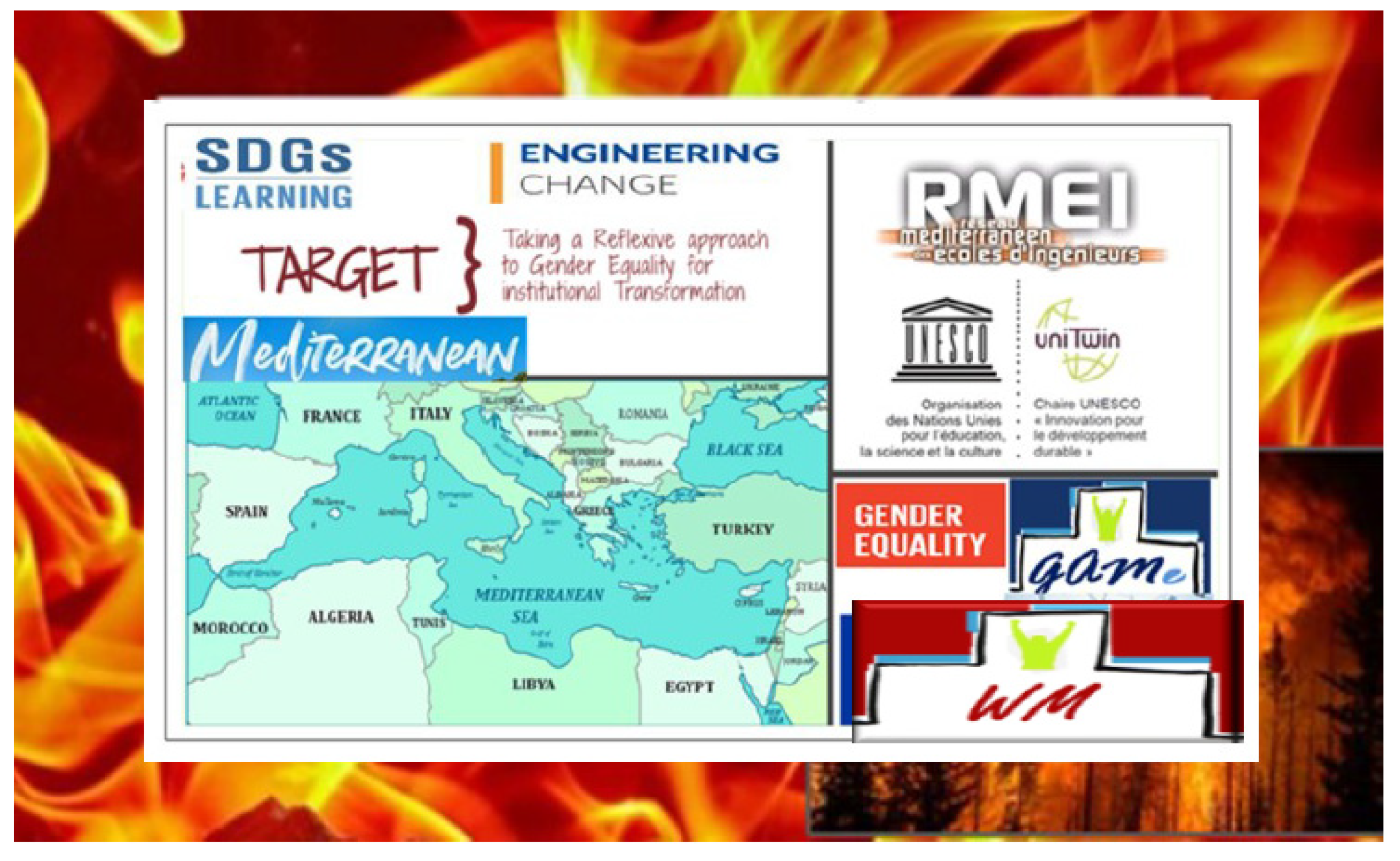
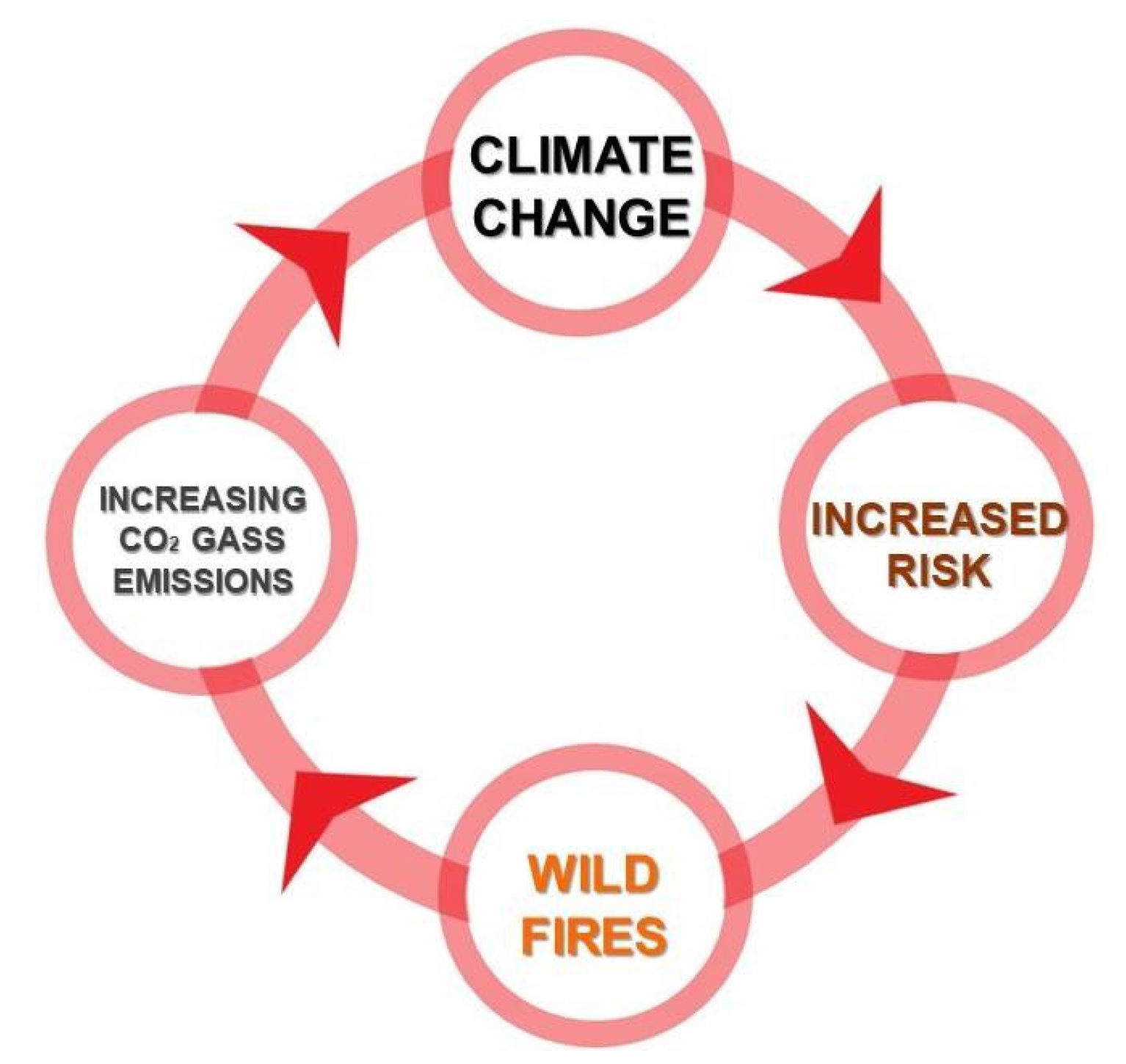
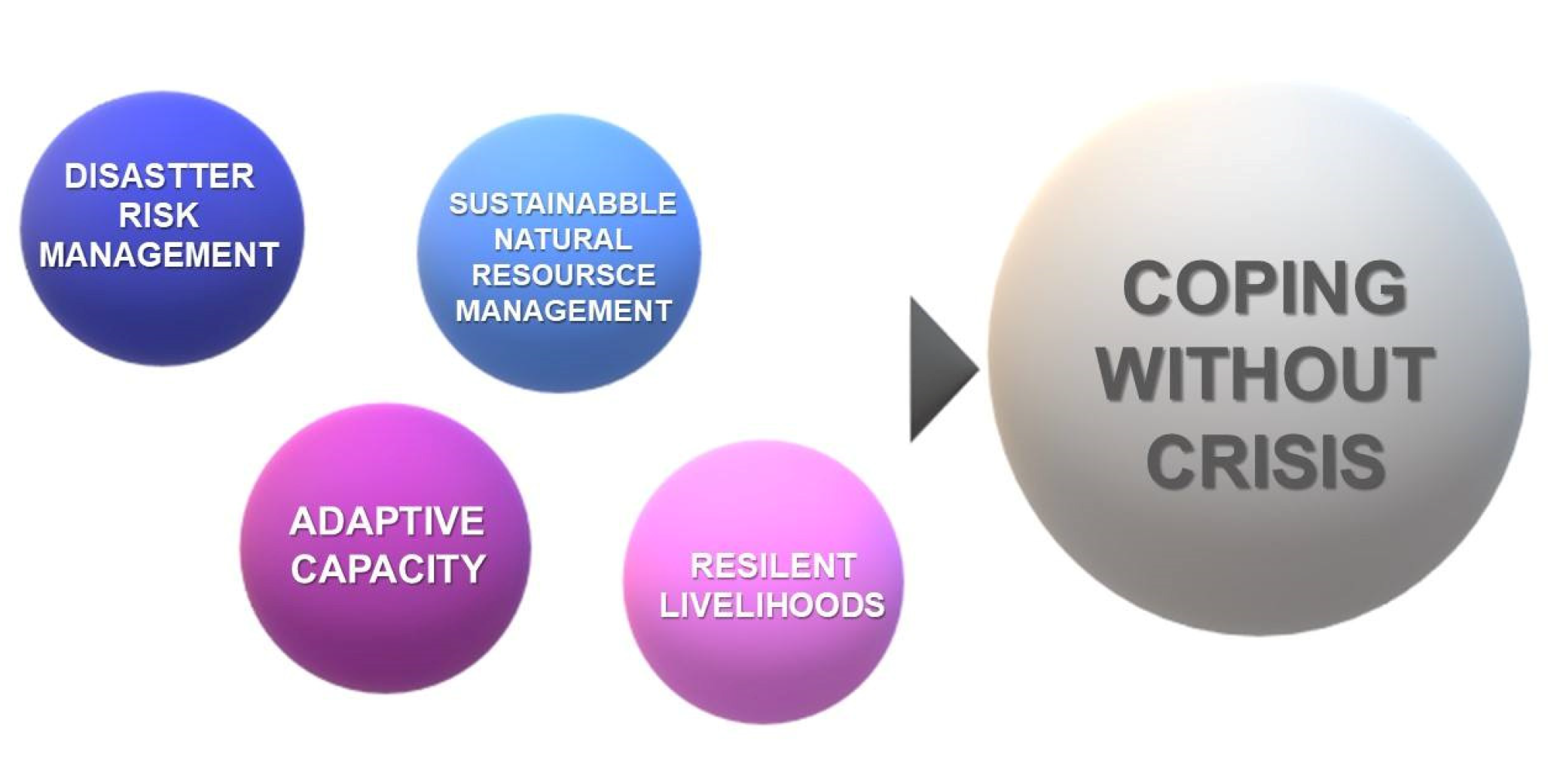
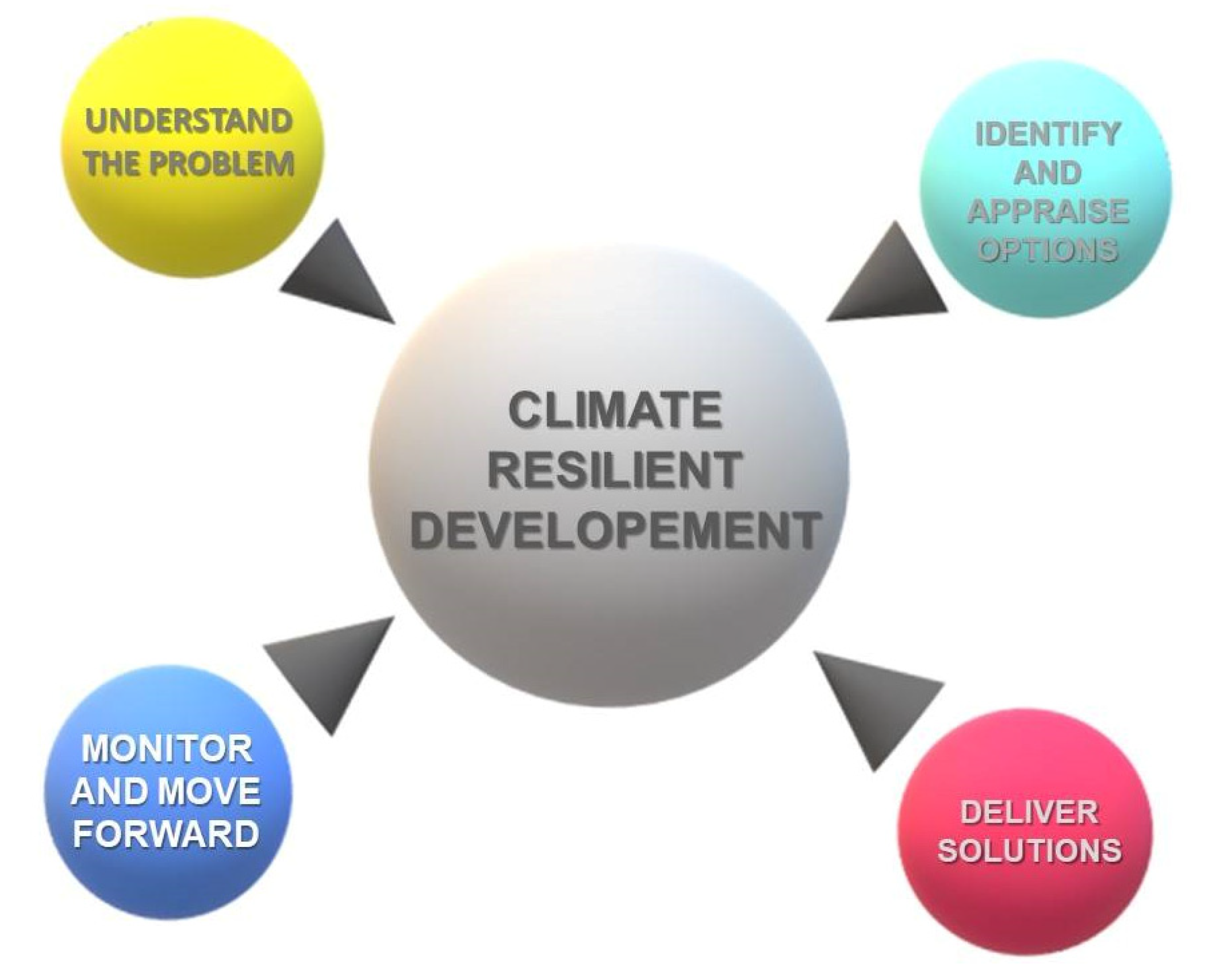
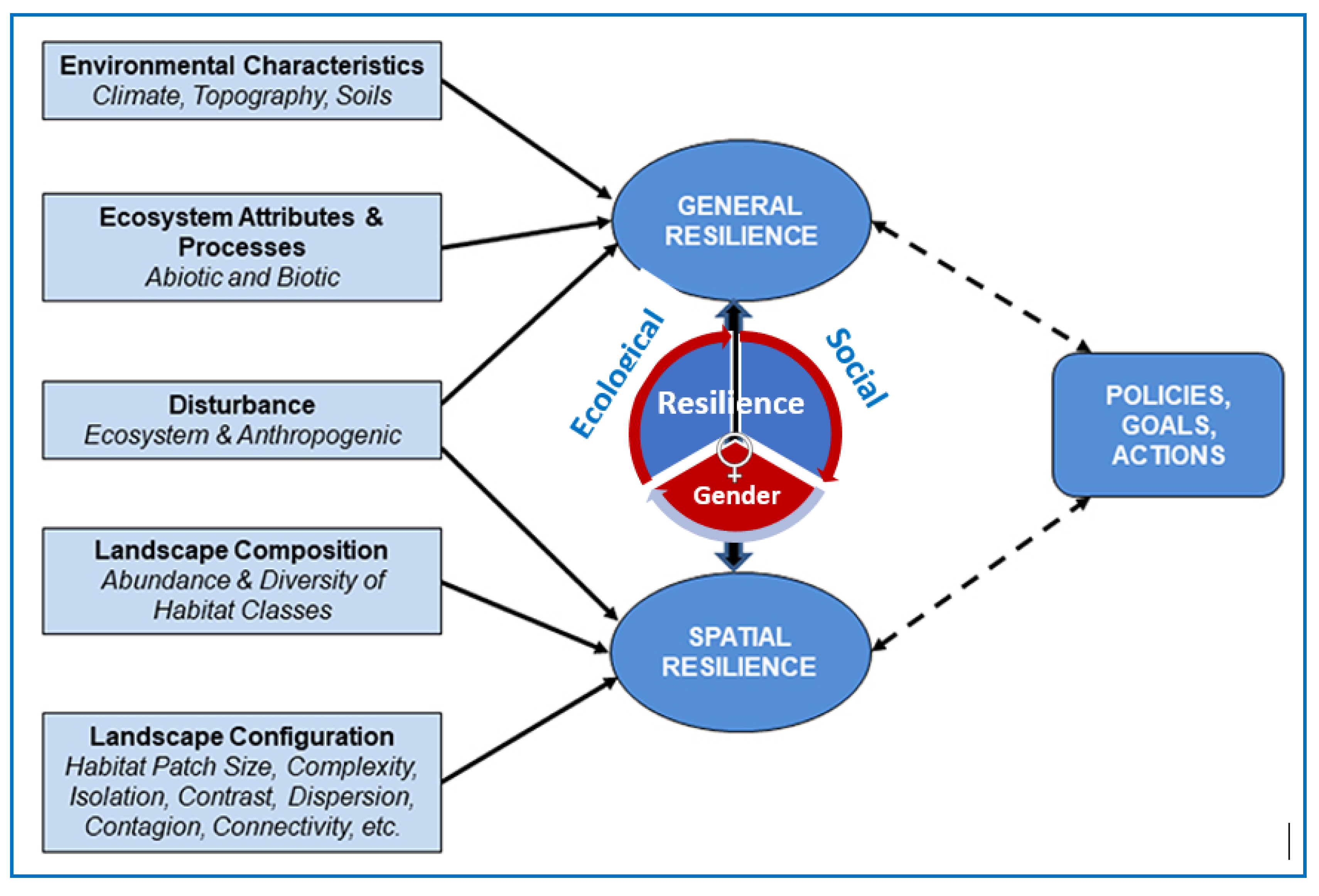
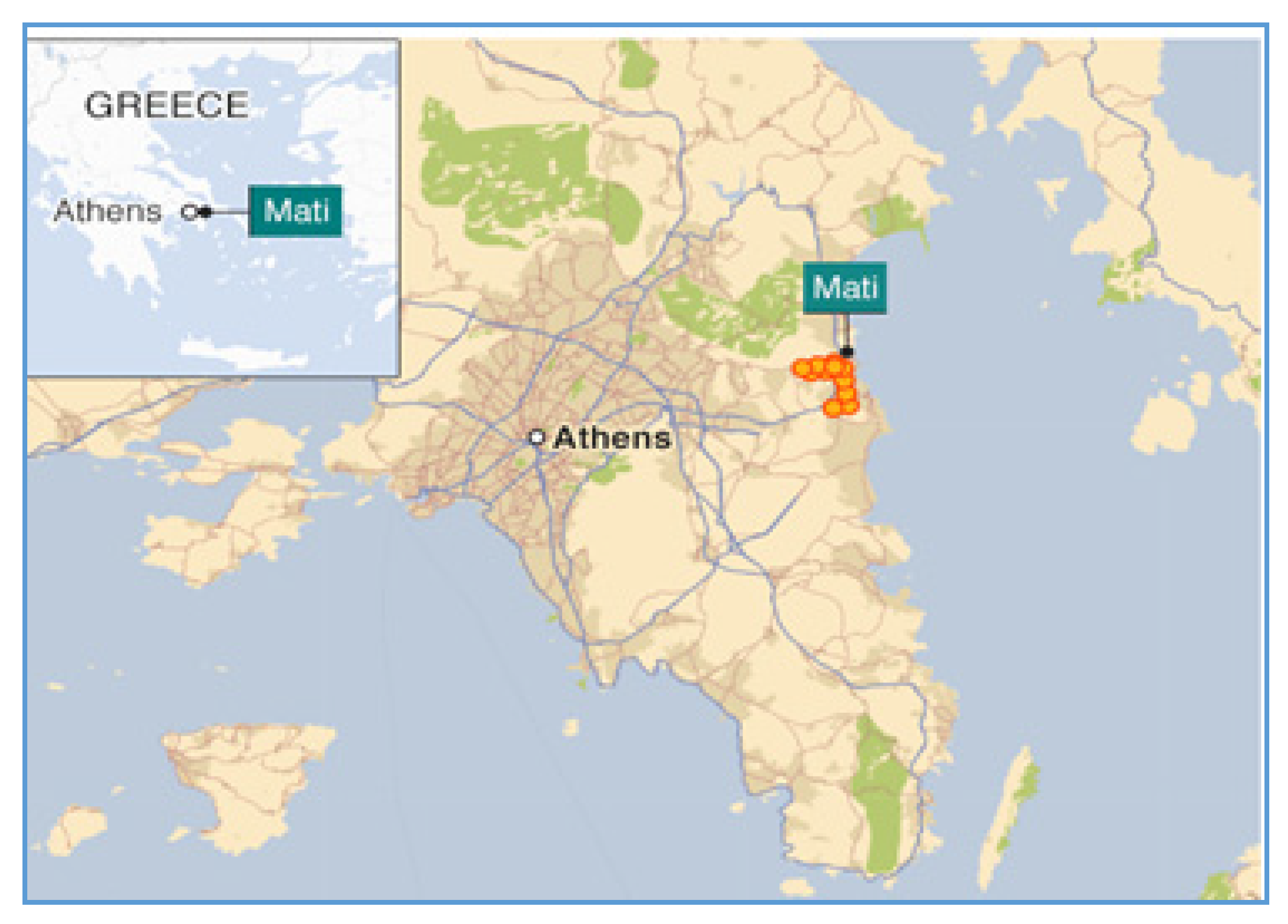
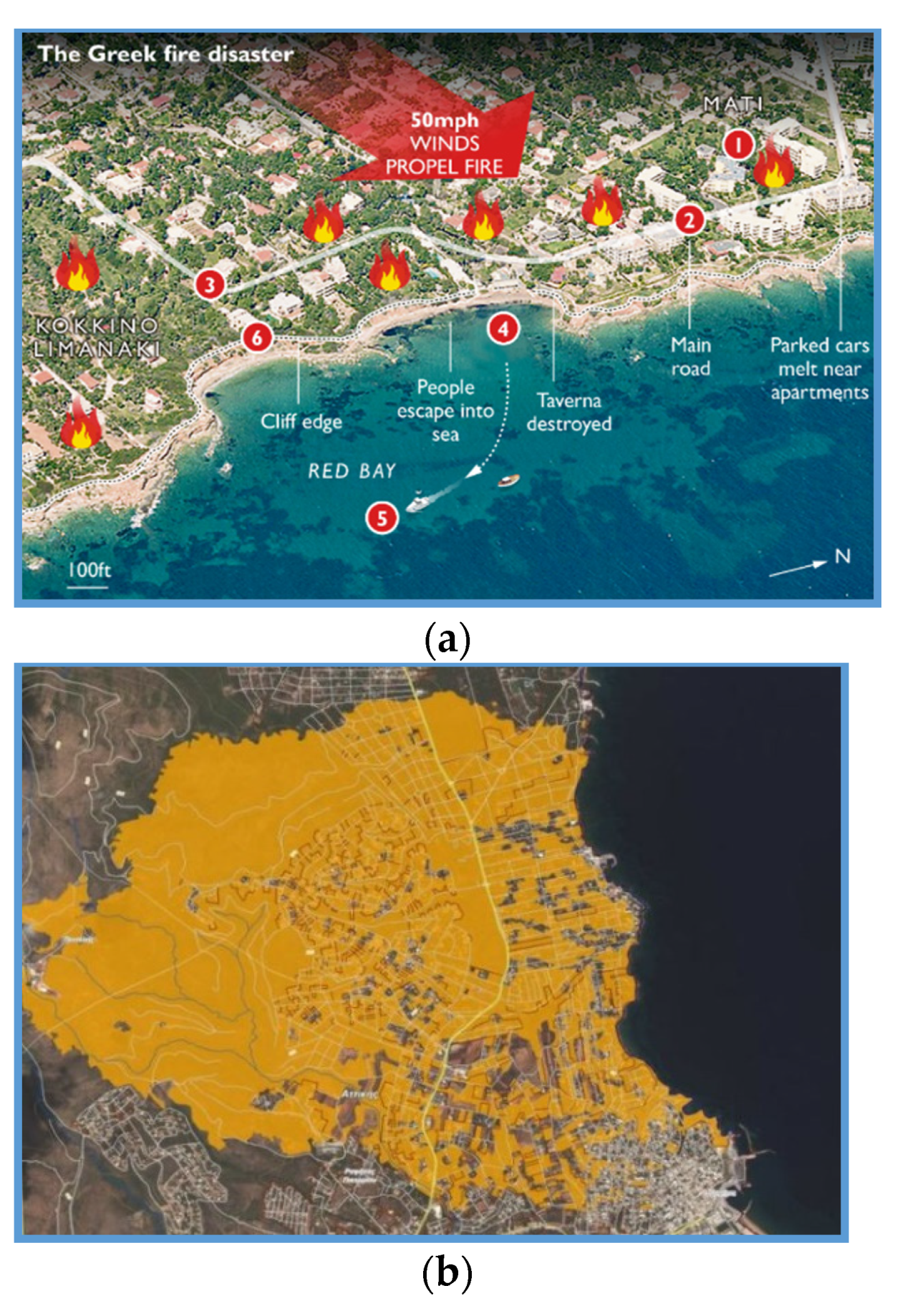
| No | Principle | Measures |
|---|---|---|
| 1 | Estimate the exposure vulnerability [84]. |
|
| 2 | Explore the sensitivity of the exposed community [84]. |
|
| 3 | Consider the levels of the adaptive capacity [84]. |
|
| 4 | Tailored fire prevention and emergency warning [48]. |
|
| 5 | Real-time mass communication [48] |
|
| 6 | Devolution of political power [48] |
|
| 7 | Think diversity [84] |
|
| 8 | Increase participation [85]. |
|
| 9 | Boost gender equality [86]. |
|
| 10 | Include public education [48] |
|
| 11 | Post disaster Waste management |
|
| No | Recommendations |
|---|---|
| 1 | Co-work with residents to reduce flammability in their community. |
| 2 | Co-share information with residents. |
| 3 | Collaborate with them to develop trust. |
| 4 | Learn from them about their special needs. |
| 5 | Co-explore the barriers of economic, gender, age, and language, within the community. |
| 6 | Co-work with owners to reduce the risk of their home burning, increase defensible space around their homes. |
| 7 | Collaborate with the waste management planners and local/regional administration on how to optimize the collection and recycling of wastes, based on these assessments. |
| 8 | Collaborate with forestry administration on how to clean forest from flammable bio residues and create a partnership with a local utility company to remove dead trees near power infrastructure. |
| 9 | Identify pre-attack zones for evacuation planning and develop clear maps showing water supply and equipment staging areas. |
| 10 | Collaborate with the administration of urban planning and constructions to define the standards and type of building material for the area in risk. |
| 11 | Create a partnership with a local utility company to remove dead trees near power infrastructure, reduce roadside fuels along strategic private pathways. |
| 12 | Keep pathways free and clear with clear guiding signs. Wider driveways to help residents to evacuate faster. |
| 13 | Improve evacuation preparedness based on these assessments. |
| No | Gender-Sensitive Approaches |
|---|---|
| 1 | Employ women at all levels of fire management, waste, and forestry management. |
| 2 | Build capacity for women of the area to acquire the skills and knowledge for fire management. |
| 3 | Develop roles for women to act appropriately in a hazard and post-hazard time. |
| 4 | Co-create respect and trust in women’s ability. |
| 5 | Empower women to stand up for their knowledge and experience. |
| 6 | Create a more diverse view of resilience by using other social unequal relationship to fire. |
| 7 | Collaborate to uplift women to participate in fire management and planning by changing the historical, cultural, or political bias behind them. |
| 8 | Vote for those that express a strong political will for climate resilience societies, could be regarding the complex issues of climate adaptation. |
| 9 | Keep all stakeholders closely involved. |
| 10 | Train the community to understand the mitigation plan and recognize the danger of wildfire, and to recognize women’s power. |
| 11 | Enhance the quality and scope of team discussions, by keeping them open, equal, and not dominated by ideologies. |
| No | Positive Arguments |
|---|---|
| 1 | Women fire scientists have contributed significant new insights and perspectives for the future of fire science. |
| 2 | Women have the knowledge and understanding of what it takes to adapt to changing environmental conditions in order to identify practical solutions. |
| 3 | Women bring more empathy and inclusion in defense and problem solving, which enhances their effectiveness as sustainability leaders. |
| 4 | Women remain largely untapped due to existing prejudices. |
| 5 | To effectively mitigate climate change, we need to harness the knowledge and skills of women. |
| 6 | Women have the right to equal participation. |
| 7 | Once in leadership roles, they can make a difference that benefits whole societies. |
Publisher’s Note: MDPI stays neutral with regard to jurisdictional claims in published maps and institutional affiliations. |
© 2021 by the authors. Licensee MDPI, Basel, Switzerland. This article is an open access article distributed under the terms and conditions of the Creative Commons Attribution (CC BY) license (http://creativecommons.org/licenses/by/4.0/).
Share and Cite
Zabaniotou, A.; Pritsa, A.; Kyriakou, E.-A. Observational Evidence of the Need for Gender-Sensitive Approaches to Wildfires Locally and Globally: Case Study of 2018 Wildfire in Mati, Greece. Sustainability 2021, 13, 1556. https://doi.org/10.3390/su13031556
Zabaniotou A, Pritsa A, Kyriakou E-A. Observational Evidence of the Need for Gender-Sensitive Approaches to Wildfires Locally and Globally: Case Study of 2018 Wildfire in Mati, Greece. Sustainability. 2021; 13(3):1556. https://doi.org/10.3390/su13031556
Chicago/Turabian StyleZabaniotou, Anastasia, Anastasia Pritsa, and E-A Kyriakou. 2021. "Observational Evidence of the Need for Gender-Sensitive Approaches to Wildfires Locally and Globally: Case Study of 2018 Wildfire in Mati, Greece" Sustainability 13, no. 3: 1556. https://doi.org/10.3390/su13031556
APA StyleZabaniotou, A., Pritsa, A., & Kyriakou, E.-A. (2021). Observational Evidence of the Need for Gender-Sensitive Approaches to Wildfires Locally and Globally: Case Study of 2018 Wildfire in Mati, Greece. Sustainability, 13(3), 1556. https://doi.org/10.3390/su13031556






